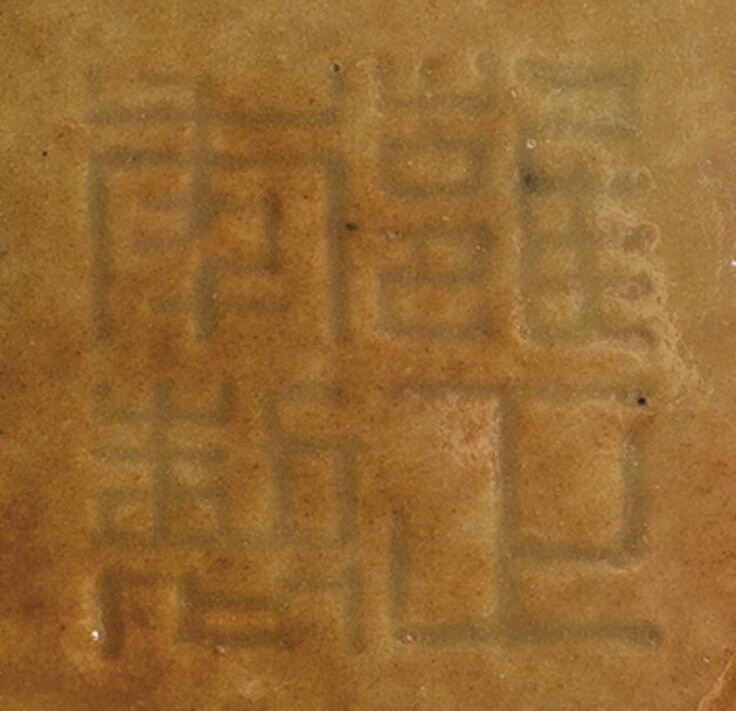A rare flambé-glazed vase, Incised seal mark and period of Yongzheng (1723-1735)
Lot 106. A rare flambé-glazed vase, Incised seal mark and period of Yongzheng (1723-1735); 33.7 cm., 13 1/4 in. Estimate 1,500,000 — 2,000,000 HKD (171,024 - 228,032 EUR). Lot sold 2,480,000 HKD. Photo: Sotheby's 2015.
robustly potted with a body of squat angular profile rising from a short splayed foot to an angular shoulder and surmounted by a tall waisted neck and a slightly splayed rim, the exterior unctuously covered with a rich crimson glaze suffused with darker streaks of reddish-purple draining downwards from the galleried rim, the interior covered with a lavender-blue glaze suffused with a network of faint crackles, the base with a thin pale brown and olive-green glaze and incised with a four-character seal mark.
Provenance: Sotheby's Hong Kong, 29th November 1979, lot 308.
Sotheby's Hong Kong, 20th May 1987, lot 485.
Note: This vase is notable for its rich ruby-streaked glaze, which imitates Song dynasty Jun glaze. This beautiful effect, known as yaobian (‘transmutation glaze’) was much sought after by the Yongzheng emperor, who commissioned copies of Jun wares from the Imperial workshop in Jingdezhen. The technical ingenuity and high level of experimentation of the potters working at the imperial kiln, is evident in the official list from 1732, which records no less than nine varieties of Jun glazes inspired by ancient specimens (see Stephen W. Bushell, Oriental Ceramic Art, London, 1981, pp. 196-6).
Vases of this form, with angled shoulders and cylindrical section are rare, although a closely related vase was sold at Christie’s Hong Kong, 30th May 2006, lot 1352. Compare also Yongzheng mark and period vases of similar form, but with two bands of ruyi heads on the shoulders and above the foot and a pair of handles, such as one in the Huaihaitang collection, sold in our London rooms, 19th June 1984, lot 298, and again in these rooms, 16th November 1988, lot 320, and included in the exhibition Ethereal Elegance. Porcelain Vases of the Imperial Qing, Art Museum, The Chinese University of Hong Kong, Hong Kong, 2007, cat. no. 67.
Created by applying three different glaze mixes, flambé-glazed wares were much sought after by contemporary connoisseurs, some of whom considered them superior to their Song dynasty prototypes. Lan Pu in his Jingdezhen tao lu(Accounts of Ceramics at Jingdezhen), completed at the end of the Qianlong reign (1735-1796), notes that ‘Jun ware red pieces that the ancients made were composed of rough, coarse-grained clay tinged with yellow, and though the glaze colour is lively they are not fine pieces. Today Jingdezhen selects clean, fine, white clay to mould the body, and then applies red glaze. In this way the red colour has a much richer appearance’ (see Rose Kerr, ‘Jun Wares and Their Qing Dynasty Imitation at Jingdezhen’, Rosemary E. Scott, The Porcelains of Jingdezhen. Colloquies on Art & Archaeology in Asia No. 16, London, 1993, p. 155).
Sotheby's. Yongzheng – The Age of Harmony and Integrity, Hong Kong, 07 avr. 2015

/https%3A%2F%2Fprofilepics.canalblog.com%2Fprofilepics%2F1%2F0%2F100183.jpg)
/https%3A%2F%2Fstorage.canalblog.com%2F03%2F02%2F119589%2F96711876_o.jpg)
/https%3A%2F%2Fstorage.canalblog.com%2F11%2F31%2F119589%2F94773502_o.jpg)
/https%3A%2F%2Fstorage.canalblog.com%2F20%2F83%2F119589%2F94772815_o.jpg)
/https%3A%2F%2Fstorage.canalblog.com%2F26%2F72%2F119589%2F75604929_o.jpg)
/https%3A%2F%2Fstorage.canalblog.com%2F59%2F60%2F119589%2F26458628_o.jpg)




/http%3A%2F%2Fstorage.canalblog.com%2F54%2F95%2F119589%2F129597348_o.jpg)
/http%3A%2F%2Fstorage.canalblog.com%2F73%2F74%2F119589%2F129152835_o.jpg)
/http%3A%2F%2Fstorage.canalblog.com%2F72%2F85%2F119589%2F128589817_o.jpg)
/http%3A%2F%2Fstorage.canalblog.com%2F92%2F83%2F119589%2F128095677_o.jpg)